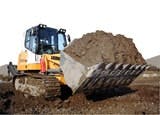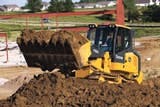- John Deere
- Caterpillar
- Liebherr
- 'Think big'
- The Cost of Ownership
- Crawler-Loader Specifications (by horsepower)
With the total number of models at less than 40 percent from a decade ago, and with just three manufacturers still in the game, it would be easy to look at the full-sized crawler loader market and conclude its rich place in history.
Not so fast.
The three manufacturers offering full-sized crawler loaders – Caterpillar, Liebherr and John Deere – continue to not only update their models, but also to promote the crawler-loader's useful role on jobsites and in the equipment fleets of smart managers. Each product line offers three model sizes.
"The folks I talk to when I travel, they swear by track loaders, and it's all about keeping the rest of their fleet utilized," says Dave Cusac, track-type tractor product application specialist with Caterpillar's excavation and earthmoving divisions. "If they're moving bedding material and they just had a day of rain or two, 6 psi is a lot better than 30 psi, when you're looking at track ground pressure versus wheels, and still keeping up and keeping some of those machines moving. It was very clear that those folks are very passionate about their usage of the track loaders."
While at a recent product launch for the D7E electric-drive dozer in San Antonio, Texas, Cusac met a customer who operates only Caterpillar 963 and 973 "track-type" loaders. "He said, 'I can do everything with my track loader that they can do with that tractor, and more.'" Texas is one of the regions in the continent where crawler loader usage prevails and even flourishes, and the area contractor already sold on the machine type is certain to be pleased by news coming out of Caterpillar now. Following the 2007 introduction of D-Series versions of the 953 and 963 track loaders, with increases of more than 15 and 25 percent in horsepower to 148 and 189, respectively, Caterpillar is now ramping up to produce the D-Series version of the market's largest machine, the 973.
"A lot of the same features and benefits that we built into the smaller D-Series were also incorporated into the 973 size," says Cusac's Caterpillar colleague Ken Nebergall, adding that the 973D will blow away "those customers who value what the 973C has done for them."
The other market players are busy, too.
This past summer, Liebherr introduced the 101-horsepower LR 614 and 143-horsepower LR 624 to join the previously released 184-horsepower LR 634, "to provide a full range of Liebherr-designed and -manufactured crawler loaders with bucket capacities from 1.57 to 3.14 cubic yards," says Duane Wilder, president, Liebherr Construction Equipment. "In the fall of 2008, we announced that we would discontinue our dual-branding relationship with John Deere for crawler loaders beginning in 2010. The introduction of the LR 614 and LR 624 are the first new models with Tier 3 engines available in North America exclusively under the Liebherr brand."
With the compact LR 614, Liebherr became the first manufacturer to supply a Tier 3 machine in this class, the company says. The LR 624 replaces the LR 622 with a continuation of the modern styling and design of the LR 634, but while maintaining the established hydrostatic drive system.
Topping the John Deere product family, the 181-horsepower D-Series version of the 755 offers upgraded styling and controllability, and uses a Deere PowerTech engine versus the previous Liebherr power plant. At the smaller end, the 99-horsepower 605C incorporates the rear-engine design of the 655C-II and 755D. "We wanted to get the benefits of a larger machine. With the engine in the rear, you get a lot better visibility and a little bit better balanced machine, and we wanted to carry that forward into that smaller size class," says Scott Bayless, crawler product consultant with John Deere Construction & Forestry, and another believer in the benefits of the crawler loader. "It can do excavation work like an excavator, but you can actually haul the material away and stockpile it, versus just casting it off to the side."
For digging basements, the ever-popular crawler excavator has its limitations, to which the crawler loader offers alternatives, says Caterpillar's Cusac. "Those become more and more clearly defined by the carry distance. If you're working outside of the reach of the excavator, then you would go to something such as the track loader to do similar tasks."
The versatility of the track loader, says Nebergall, shines through as a complementary tool in landfill applications, and can even offer a consolidation of machines on sewer and water-main jobs. "Especially nowadays," adds Cusac, "when customers are wanting to do so many different tasks on a jobsite with just one machine or one operator."
It's not just traditional basement diggers who can benefit from the crawler loader, but any contractor who accepts "how productive they can be with this big skid steer loader," says Nebergall, who uses the compact-loader reference deliberately. "I think most of our customers all over the U.S. and the world understand the value of those products," he explains. "Well, when you look at the current track loaders - 953D, 963D, and the 973D - you can very easily visualize that it's just a larger and more productive version of those smaller machines."
And recent product developments will help in the understanding, says Nebergall, tractor-type tractor and track loader product sales engineer with Caterpillar's earthmoving division. "The joystick steering system is a new option that allows the newer, younger operator to get on a machine and learn this machine very quickly," he says, "or if he's already been running one of these compact track loaders or skid steers, he already knows those controls."
The regional markets where crawler loaders prevail include the U.S. Northeast and Midwest. "Typically, the crawler-loader market is somewhat finicky," says Deere's Bayless, "because you've got pockets around the country where you have contractors who have used them and have always used them. You've got other pockets around the country where guys used to use them, but have switched to excavators or even wheel loaders. Typically, the guy who is going to be using a crawler loader is doing excavation work in an area that has soft underfoot conditions, that a wheel loader can't do because it's too soft, or an excavator could do but there's not room enough to get a truck in to haul the material away."
Cusac says it often boils down to soil type. "If you use just the state of Ohio as an example: Northern Ohio, you have rock; southern Ohio, you have clay," he says. "A lot more prevalent track-loader customers are pocketed in that southern region versus up in the north." Adds Nebergall: "We've got customers who are very intelligent; they are very careful about how they spend their money, and these are the guys who are still buying track loaders. So, obviously, there's something of economic value by using these machines."
Don't write the last chapter just yet.
John Deere
Largest Model Boasts Total Machine ControlClick Image to Enlarge Not only the largest in the three-model product family, but also the first John Deere D-Series crawler loader introduced, the 181-horsepower 755D (shown here) incorporates a double final drive seal arrangement that alerts the operator in the event of a failure. Also, with Deere's PowerTech Plus engine and Total Machine Control (TMC) system, the 755D's operating characteristics can be tailored to match the operator's preferences. Uniquely at the other end of the model offering, the 99-horsepower 605C carries over the rear engine design of its larger counterparts, providing enhanced visibility and machine balance for performance and operating characteristics similar to the 130-horsepower 655C-II and the 755D. Like all Deere crawler loaders, the 605C has a rearward tilting cab for service access. V-pattern transmission control is standard; joystick control is optional.Click here for more information
Caterpillar
Most Powerful Track Loader On the MarketClick Image to Enlarge Having introduced the 953D and 963D track-type loaders two years ago, Caterpillar is now following suit with the D-Series introduction of the largest crawler loader in the market, the 973. At 148 and 189 net horsepower, respectively, up by more than 15 and 25 percent, respectively, over predecessor models, the Caterpillar 953D and 963D (shown here) are powered by the Cat C6.6 ACERT engine. An electronically controlled hydrostatic drive system provides independent power and control of each track, offering fast acceleration, infinitely variable speeds, and automatic, on-the-go, direction changes. A new sealed and pressurized cab tilts for service access.Click here for more information
Liebherr
Two Exclusive Models Update LineClick Image to Enlarge Introduced this summer, the LR 614 and LR 624 are the first new crawler-loader models with Tier 3 engines available in North America exclusively under the Liebherr brand. They join the previously introduced LR 634 to provide a full range of Liebherr-designed and -manufactured crawler loaders with bucket capacities ranging 1.57 to 3.14 cubic yards. The 101-horsepower LR 614 (shown here), while compact in size at a base operating weight of less than 25,000 pounds, boasts a tipping load of 16,751 pounds. The 143-horsepower LR 624 is a successor to the LR 622, representing a continuation of a design introduced with the 184-horsepower LR 634 while maintaining the hydrostatic drive system. The new, larger cab features single joystick control and a single-piece curved windshield. Both new models have available 4-in-1 buckets and rear-mounted rippers as options.Click here for more information
Additional Product Information: Attachments Add Versatility to Crawler Loaders







